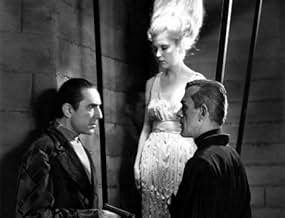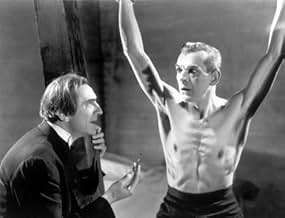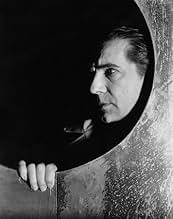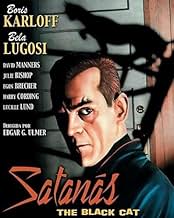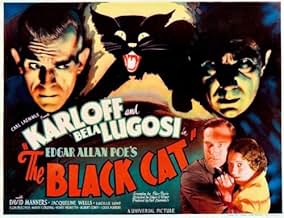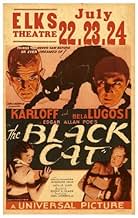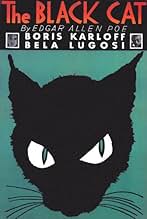Aggiungi una trama nella tua linguaStranded honeymooners follow mad doctor to manor.Stranded honeymooners follow mad doctor to manor.Stranded honeymooners follow mad doctor to manor.
- Regia
- Sceneggiatura
- Star
- Premi
- 2 vittorie e 1 candidatura in totale
Boris Karloff
- Hjalmar Poelzig
- (as Karloff)
Julie Bishop
- Joan Alison
- (as Jacqueline Wells)
Virginia Ainsworth
- Cultist
- (non citato nei titoli originali)
Luis Alberni
- Train Steward
- (non citato nei titoli originali)
King Baggot
- Cultist
- (non citato nei titoli originali)
Herman Bing
- Car Steward
- (non citato nei titoli originali)
Symona Boniface
- Cultist
- (non citato nei titoli originali)
John Carradine
- Cult Organist
- (non citato nei titoli originali)
André Cheron
- Train Conductor
- (non citato nei titoli originali)
George Davis
- Bus driver
- (non citato nei titoli originali)
Andy Devine
- Bit Part
- (non citato nei titoli originali)
Recensioni in evidenza
There's a lot of story to tell in about 65 minutes, so this movie could be considered perhaps a bit incoherent. But the larger themes -- revenge, lust and innocents caught in the grip of forces beyond their sheltered experience -- have been central themes in horror tales for centuries.
Karloff is a delight as usual, and there are many fine details to his performance -- including a brief but outrageously lustful stare at the half-dressed young wife of the innocent couple and the strangely gentle way his brutal character handles a cat. (Nice tall, dark and handsome kitty in the title role, for the cat people.)
And this movie also shows once again that Bela Lugosi was a better actor than he ever got credit for. He handles his overwrought dialogue with taste and good cheer, and he's a marvel. And he even gets to speak a few rare lines of Hungarian here.
Karloff is a delight as usual, and there are many fine details to his performance -- including a brief but outrageously lustful stare at the half-dressed young wife of the innocent couple and the strangely gentle way his brutal character handles a cat. (Nice tall, dark and handsome kitty in the title role, for the cat people.)
And this movie also shows once again that Bela Lugosi was a better actor than he ever got credit for. He handles his overwrought dialogue with taste and good cheer, and he's a marvel. And he even gets to speak a few rare lines of Hungarian here.
Other commentaries will fill you in on the nearly-incomprehensible plot (if that's possible) but, as has been pointed out, you don't watch a film like this for plot.
Despite the story inconsistencies and implausibilities, everything here just seems to "jell:" the fabulous sets, elegant photography, evocative music (drawing heavily from Schubert, among others) and the downright creepy atmosphere woven from the themes of jealousy, lust, revenge, murder, sadism.....all sounds delightfully sick, doesn't it? Truly, it's nowhere near as threatening as it sounds; indeed, if Astaire and Rogers had ever made a spooky thriller, it might have looked and felt something like this one. THE BLACK CAT possesses a lyrical, rhythmic quality, upon which we drift through a sleek, ultra-modern nightmare world.
One of the reasons it all works is its ability to pull us into a sort of parallel universe which, though it looks more or less like reality as we know it, glides along on a barely-concealed undercurrent - an "atmosphere of death," as Lugosi's character puts it - where things happen that "could never actually happen" (an inside reference for those who know the film).
There are some wonderful set-pieces, such as Karloff's tour through a most unusual basement mausoleum/museum memorializing all of his dearly departed earlier "wives." And of course, Boris and Bela deliver, with their restrained but full-bodied performances. Karloff conveys menace just entering a room, and Lugosi has an all-too-rare opportunity to display some tenderness; notice the single tear that rolls down his face as he learns - and sees - what became of the wife that Karloff stole from him years before.
A very stylized - and stylish - film which grants us the unusual treat of seeing Lugosi play a (more or less) "good guy," and the unique one of hearing him pronounce the word "baloney," as only he could.
Despite the story inconsistencies and implausibilities, everything here just seems to "jell:" the fabulous sets, elegant photography, evocative music (drawing heavily from Schubert, among others) and the downright creepy atmosphere woven from the themes of jealousy, lust, revenge, murder, sadism.....all sounds delightfully sick, doesn't it? Truly, it's nowhere near as threatening as it sounds; indeed, if Astaire and Rogers had ever made a spooky thriller, it might have looked and felt something like this one. THE BLACK CAT possesses a lyrical, rhythmic quality, upon which we drift through a sleek, ultra-modern nightmare world.
One of the reasons it all works is its ability to pull us into a sort of parallel universe which, though it looks more or less like reality as we know it, glides along on a barely-concealed undercurrent - an "atmosphere of death," as Lugosi's character puts it - where things happen that "could never actually happen" (an inside reference for those who know the film).
There are some wonderful set-pieces, such as Karloff's tour through a most unusual basement mausoleum/museum memorializing all of his dearly departed earlier "wives." And of course, Boris and Bela deliver, with their restrained but full-bodied performances. Karloff conveys menace just entering a room, and Lugosi has an all-too-rare opportunity to display some tenderness; notice the single tear that rolls down his face as he learns - and sees - what became of the wife that Karloff stole from him years before.
A very stylized - and stylish - film which grants us the unusual treat of seeing Lugosi play a (more or less) "good guy," and the unique one of hearing him pronounce the word "baloney," as only he could.
I won't comment about the acting or plot -- there's plenty of that here already. What I'd rather do is call attention to the visuals -- the cinematography, lighting, costuming, and especially the set design.
Normally, horror films take place in ancient settings -- crude medieval fortresses and rustic castles that are dark, cluttered and gloomy. But this one is set in a perversely utopian sci-fi fantasy -- the clean lined, impeccably detailed, generously glazed modernistic and (usually) radiantly lit white-and-silver upper floor interiors of the house.
The lower floor is an expressionistic prison, also clean lined, but still dungeon-like with its windowless walls of exposed board-formed concrete. An elegant steel spiral staircase connects the two, and the angular expressionism reaches its culmination in the chamber used for the black mass.
Karloff's costumes recall Oskar Schemmer's Bauhaus-produced work -- angular, broad-shouldered, narrow-waisted and elegant. Even the haircut of this man of the future in sharp and angular. His character is an engineer and architect and is given the name -- Poelzig -- of a famous expressionist German architect and film set designer of the time, who was a colleague of the director on an earlier film. The elegant futurism in carried down to the detail level, including a digital night-table clock and an abstract chess set. Much of the genius of this movie is that it breaks the horror-movie visual mold, and floods it with light, creating a fascinating tension between plot and setting.
Normally, horror films take place in ancient settings -- crude medieval fortresses and rustic castles that are dark, cluttered and gloomy. But this one is set in a perversely utopian sci-fi fantasy -- the clean lined, impeccably detailed, generously glazed modernistic and (usually) radiantly lit white-and-silver upper floor interiors of the house.
The lower floor is an expressionistic prison, also clean lined, but still dungeon-like with its windowless walls of exposed board-formed concrete. An elegant steel spiral staircase connects the two, and the angular expressionism reaches its culmination in the chamber used for the black mass.
Karloff's costumes recall Oskar Schemmer's Bauhaus-produced work -- angular, broad-shouldered, narrow-waisted and elegant. Even the haircut of this man of the future in sharp and angular. His character is an engineer and architect and is given the name -- Poelzig -- of a famous expressionist German architect and film set designer of the time, who was a colleague of the director on an earlier film. The elegant futurism in carried down to the detail level, including a digital night-table clock and an abstract chess set. Much of the genius of this movie is that it breaks the horror-movie visual mold, and floods it with light, creating a fascinating tension between plot and setting.
I can't imaging how this movie would have been without both Bela Lugosi and Boris Karloff, probably very very bad. The chemistry between the two is amazing.
This is one of those movies in which the story absolutely doesn't matter. The story is totally absurd and very simple (The black cat storyline has absolutely nothing to do with the movie and serves no purpose at all) but yet that is what maybe makes this movie extremely fun and easy to watch.
Watching this movie made me realize something; Bela Lugosi actually was a very good actor that was ahead of his time. The way he delivers his lines and his eye for details shows that acting was a great passion for him. Yes I think I can now be considered one of his fans.
Another great thing were the sets that were wonderful and even now 70 years later they still look very modern.
Don't expect a movie with ghouls and monsters, it rather is more fun to watch then it is scary and the Lugosi/Karloff combination is what makes this movie a real classic.
7/10
http://bobafett1138.blogspot.com/
This is one of those movies in which the story absolutely doesn't matter. The story is totally absurd and very simple (The black cat storyline has absolutely nothing to do with the movie and serves no purpose at all) but yet that is what maybe makes this movie extremely fun and easy to watch.
Watching this movie made me realize something; Bela Lugosi actually was a very good actor that was ahead of his time. The way he delivers his lines and his eye for details shows that acting was a great passion for him. Yes I think I can now be considered one of his fans.
Another great thing were the sets that were wonderful and even now 70 years later they still look very modern.
Don't expect a movie with ghouls and monsters, it rather is more fun to watch then it is scary and the Lugosi/Karloff combination is what makes this movie a real classic.
7/10
http://bobafett1138.blogspot.com/
Travelling across Eastern Europe, Peter and Joan Allison meet Dr Werdegast on the train. When the bus taking them to their destination crashes, the Allisons go with Werdegast and stay with him at the foreboding castle of Hjalmar Poelzig. However the Allisons find themselves in danger when it becomes apparent that Werdegast and Poelzig have a deadly history with each other.
Although it carries the title of his book and a credit for him on the titles, this film has little to do with Poe's work. In fact, in terms of plotting, it owes very little to anybody because, aside from the actual set up, the plot just goes all to hell very quickly. The set up is interesting and I wanted to know more about the history between these two men, then there is the thing about the black cat and Werdegast, not to mention the fact that Poelzig seems to be very interested in reading about satanic cults! However, none of this is really fully explained - this is partly due to the short run time and so much material, but it must also be blamed on the film not having a strong focus other than atmosphere.
The film still works well as the plot crumbles, but it is a little unsatisfying as it leaves so many half stories and unanswered questions. What it does do well though is atmosphere, the direction is cheap but effective and the lighting works wonders in a cheap set! The cast also contribute to this focus on atmosphere (or style) over plot (or substance). Karloff overdoes things, but he overdoes them very well! There is no real need for him to be as ominous as he is at the start but it is what we have come to expect from him. Lugosi may have tarnished his reputation towards the end of his career, but he is good here. It's hard not to laugh when seeing him convulsed with fear over the cat but he plays it well for the most part. Manners and Wells are both OK but are very much the onscreen representation of the audience and simply have to act shocked by everything and run away lots!
Overall this is a good film but only because of the atmosphere and the influence of two legendary stars in the cast. The plot had potential but not enough time is allowed for it to be explored and the focus is more on the atmosphere than the construction.
Although it carries the title of his book and a credit for him on the titles, this film has little to do with Poe's work. In fact, in terms of plotting, it owes very little to anybody because, aside from the actual set up, the plot just goes all to hell very quickly. The set up is interesting and I wanted to know more about the history between these two men, then there is the thing about the black cat and Werdegast, not to mention the fact that Poelzig seems to be very interested in reading about satanic cults! However, none of this is really fully explained - this is partly due to the short run time and so much material, but it must also be blamed on the film not having a strong focus other than atmosphere.
The film still works well as the plot crumbles, but it is a little unsatisfying as it leaves so many half stories and unanswered questions. What it does do well though is atmosphere, the direction is cheap but effective and the lighting works wonders in a cheap set! The cast also contribute to this focus on atmosphere (or style) over plot (or substance). Karloff overdoes things, but he overdoes them very well! There is no real need for him to be as ominous as he is at the start but it is what we have come to expect from him. Lugosi may have tarnished his reputation towards the end of his career, but he is good here. It's hard not to laugh when seeing him convulsed with fear over the cat but he plays it well for the most part. Manners and Wells are both OK but are very much the onscreen representation of the audience and simply have to act shocked by everything and run away lots!
Overall this is a good film but only because of the atmosphere and the influence of two legendary stars in the cast. The plot had potential but not enough time is allowed for it to be explored and the focus is more on the atmosphere than the construction.
Lo sapevi?
- QuizAmong the unconventional elements of this film was the soundtrack. At a time (early 1930s) when movie music was usually limited to the titles and credits, Edgar G. Ulmer had an almost continuous background score throughout the entire film.
- BlooperVitus identifies Kurgaal as being "near Omsk, by Lake Baikal." In reality Omsk and Lake Baikal are approximately 1000 miles apart and are nowhere near each other.
- Citazioni
Hjalmar Poelzig: Did you hear that, Vitus? The phone is dead. Even the phone is dead.
- ConnessioniEdited from Rome Express (1932)
I più visti
Accedi per valutare e creare un elenco di titoli salvati per ottenere consigli personalizzati
- How long is The Black Cat?Powered by Alexa
- What is 'The Black Cat' about?
- Is 'The Black Cat' based on a book?
- Where is Visgard located?
Dettagli
- Data di uscita
- Paese di origine
- Lingue
- Celebre anche come
- El gato negro
- Luoghi delle riprese
- Azienda produttrice
- Vedi altri crediti dell’azienda su IMDbPro
Botteghino
- Budget
- 95.745 USD (previsto)
- Lordo in tutto il mondo
- 180 USD
- Tempo di esecuzione1 ora 5 minuti
- Colore
- Proporzioni
- 1.37 : 1
Contribuisci a questa pagina
Suggerisci una modifica o aggiungi i contenuti mancanti

Divario superiore
By what name was The Black Cat (1934) officially released in India in English?
Rispondi

